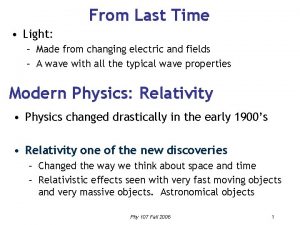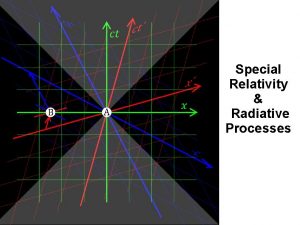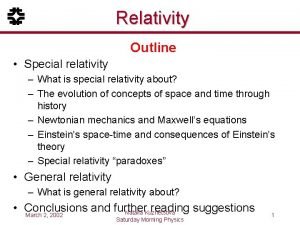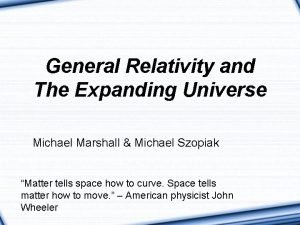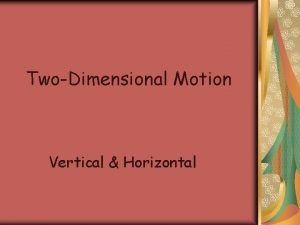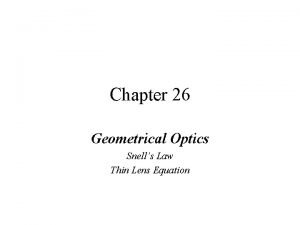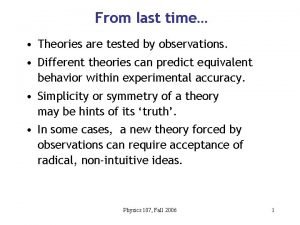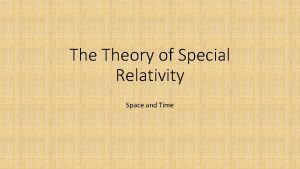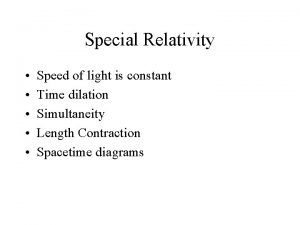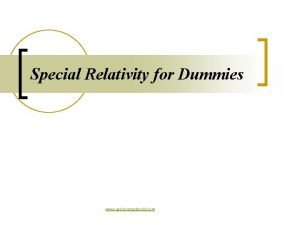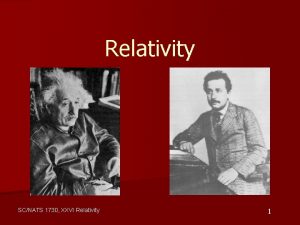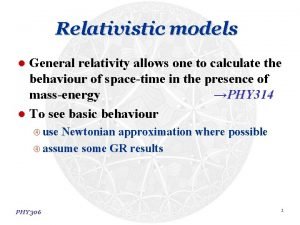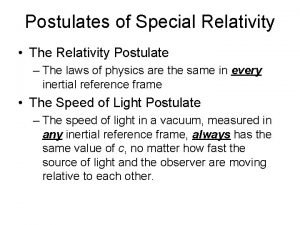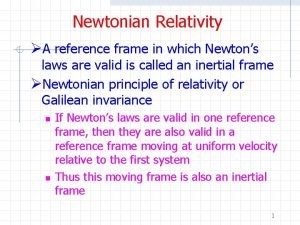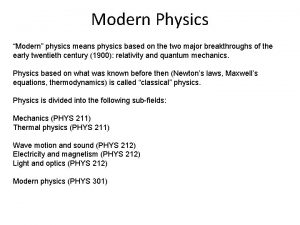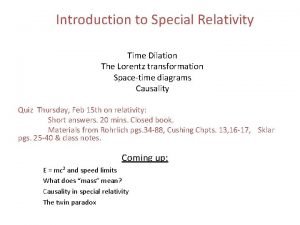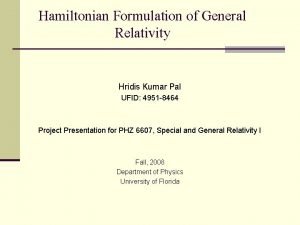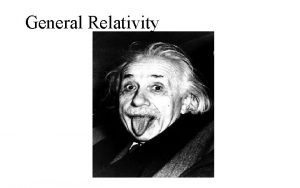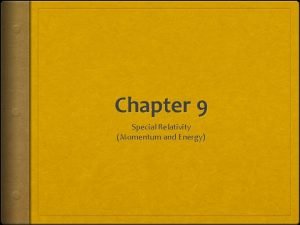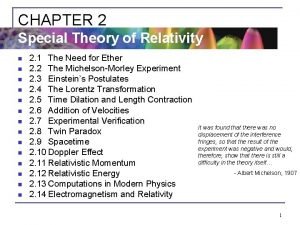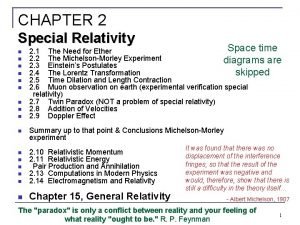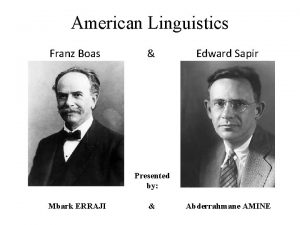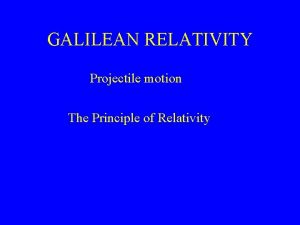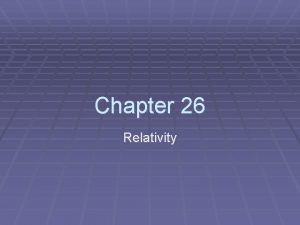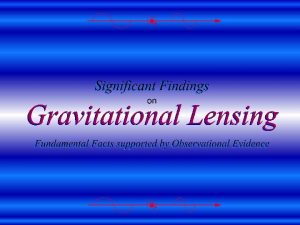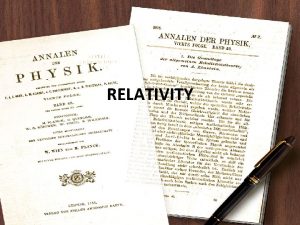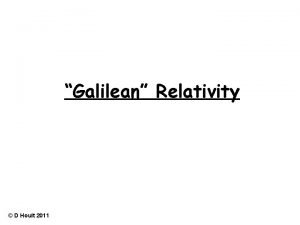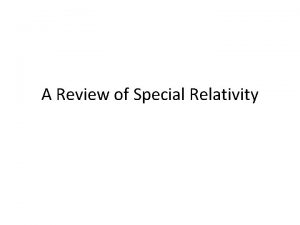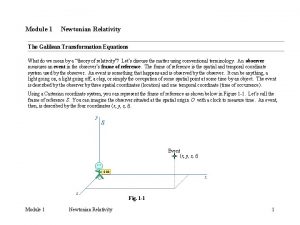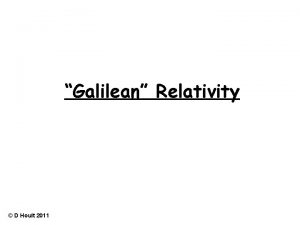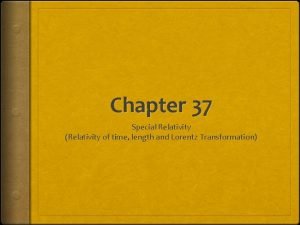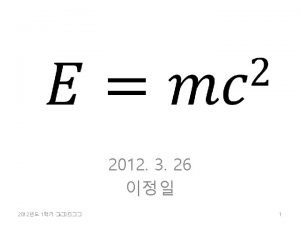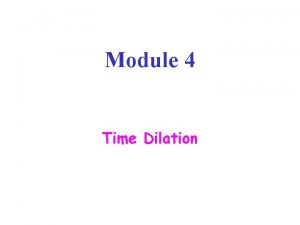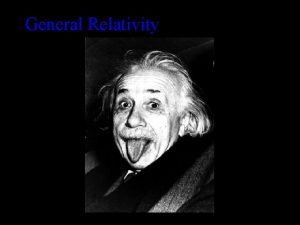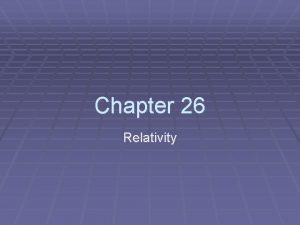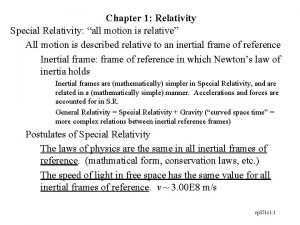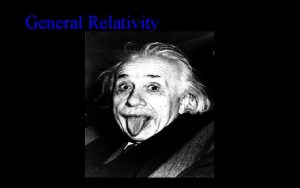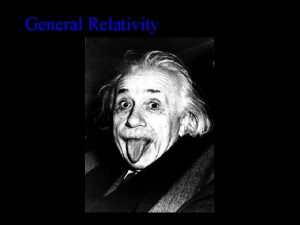From last time Galilean Relativity Laws of mechanics





























- Slides: 29

From last time… • Galilean Relativity – Laws of mechanics identical in all inertial ref. frames • Einstein’s Relativity – All laws of physics identical in inertial ref. frames – Speed of light=c in all inertial ref. frames • Consequences – Simultaneity: events simultaneous in one frame will not be simultaneous in another. – Time dilation: time interval between events appear different to different observers Phy 107 Fall 2006 1

Einstein’s principle of relativity • Principle of relativity: – All the laws of physics are identical in all inertial reference frames. • Constancy of speed of light: – Speed of light is same in all inertial frames (e. g. independent of velocity of observer, velocity of source emitting light) (These two postulates are the basis of the special theory of relativity) Phy 107 Fall 2006 2

Consequences of Einstein’s relativity • Many ‘common sense’ results break down: – Events that seem to be simultaneous are not simultaneous in different inertial frames – The time interval between events is not absolute. it will be different inertial frames – The distance between two objects is not absolute. it is different inertial frames – Velocities don’t always add directly Phy 107 Fall 2006 3

Time dilation Reference frame of Jane on train Reference frame of Joe on ground • Laser bounces up and down from mirror on train. • Joe on ground measures time interval w/ his clock. • Joe watches Jane’s clock on train as she measures the time interval. • Joe sees that these two time intervals are different. Phy 107 Fall 2006 4

Why is this? Reference frame of Joe on ground Reference frame of Jane on train • Jane on train: light pulse travels distance 2 d. • Joe on ground: light pulse travels farther • Relativity: both Joe and Jane say light travels at c – Joe measures longer travel time of light pulse • This is time dilation Phy 107 Fall 2006 5

Time dilation, continued Reference frame of Jane on train Reference frame of Joe on ground • Observer Jane on train: light pulse travels distance 2 d. • Time = distance divided by velocity = 2 d/c • Time in the frame the events occurred at same location called the proper time tp Phy 107 Fall 2006 6

Time dilation Time interval in Jane’s frame Joe measures a longer time d (v t)/2 Phy 107 Fall 2006 7

The ‘proper time’ • We are concerned with two time intervals. Intervals between two events. – A single observer compares time intervals measured in different reference frames. • If the events are at the same spatial location in one of the frames… – The time interval measured in this frame is called the ‘proper time’. – The time interval measured in a frame moving with respect to this one will be longer by a factor of Phy 107 Fall 2006 8

Atomic clocks and relativity • In 1971, four atomic clocks were flown around the world on commercial jets. • 2 went east, 2 went west -> a relative speed ~ 1000 mi/hr. • On return, average time difference was 0. 15 microseconds, consistent with relativity. First atomic clock: 1949 Miniature atomic clock: 2003 Phy 107 Fall 2006 9

Traveling to the stars Spaceship leaves Earth, travels at 0. 95 c d=4. 3 light-years Spaceship later arrives at star Phy 107 Fall 2006 0. 95 c 10

The ship observer’s frame Earth leaves… d=4. 3 light-years 0. 95 c . . then star arrives 0. 95 c Phy 107 Fall 2006 11

Comparing the measurements • The ship observer measures ‘proper time’ – Heartbeats occur at the same spatial location (in the astronaut’s chest). • On his own clock, astronaut measures his normal heart-rate of 1 second between each beat. • Earth observer measures, with his earth clock, a time much longer than the astronaut’s ( tearth = tastronaut ) Earth observer sees astronaut’s heart beating slow, and the astronaut’s clock running slow. Earth observer measures 3. 2 sec between heartbeats of astronaut. Phy 107 Fall 2006 12

The twin ‘paradox’ The Earth observer sees the astronaut age more slowly than himself. – On returning, the astronaut would be younger than the earthling. – And the effect gets more dramatic with increasing speed! – All this has been verified - the ‘paradox’ arises when we take the astronaut’s point of view. Phy 107 Fall 2006 13

• Special relativity predicts that astronaut would disagree, saying earthling is younger! • Why? d=4. 3 light-years 0. 95 c If both measure the time interval between heartbeats of the earthling, the earthling measures the proper time. Any other measurement of the time interval is longer! The astronaut says the earthling’s heart beats more slowly. Apparently a direct contradiction. Phy 107 Fall 2006 14

Resolution • Special relativity applies only to reference frames moving at constant speed. • To turn around and come back, the astronaut must accelerate over a short interval. • Only the Earthling’s determination of the time intervals using special relativity are correct. • General relativity applies to accelerating reference frames, and will make the measurements agree. Phy 107 Fall 2006 15

Total trip time Spaceship leaves Earth, travels at 0. 95 c d=4. 3 light-years Time for astronaut passes more slowly by a factor gamma. Trip time for astronaut is 4. 5 yrs/3. 2 = 1. 4 years Phy 107 Fall 2006 16

Relative velocity of reference frames Both observers agree on relative speed, hence also gamma. Speed of light v Rocket frame Earth frame v Phy 107 Fall 2006 17

Are there other ‘paradoxes’? • Both observer’s agree on the speed (0. 95 c) – Earth observer: ship moving – Ship observer: earth and star moving – They both agree on the speed • But they disagree about the total trip time. • If the time intervals are different, and speed is the same, how can distances be the same? • The distances are not the same! Length contraction Phy 107 Fall 2006 18

Length Contraction • People on ship and on earth agree on relative velocity v = 0. 95 c. • But they disagree on the time (4. 5 vs 1. 4 years). • What about the distance between the planets? Earth frame dearth = v t. Earth =. 95 (3 x 108 m/s) (4. 5 years) = 4 x 1016 m (4. 3 light years) Ship frame dship = v tship =. 95 (3 x 108 m/s) (1. 4 years) = 1. 25 x 1016 m (1. 3 light years) Phy 107 Fall 2006 19

Length contraction and proper length • Which one is correct? – Just like time intervals, distances are different in different frames. – There is no preferred frame, so one is no more correct than the other. • The ‘proper length’ Lp is the length measured in a frame at rest with respect to objects – Here the objects are Earth and star. Length in moving frame Length in object’s rest frame Phy 107 Fall 2006 20

Is any measurement the same for all observers? The real ‘distance’ between events • Need a quantity that is the same for all observers • A quantity all observers agree on is • Need to look at separation both in space and time to get the full ‘distance’ between events. • In 4 D: 3 space + 1 time • The same or ‘invariant’ in any inertial frame Phy 107 Fall 2006 21

Events in the Earth Frame • Event #1: leave earth 0. 95 c d=4. 3 light-years (LY) 0. 95 c • Event #2: arrive star Phy 107 Fall 2006 22

A relativistic invariant quantity Earth Frame Ship Frame Event separation = 4. 3 LY Event separation = 0 LY Time interval = 4. 526 yrs Time interval = 1. 413 yrs • The quantity (separation)2 -c 2(time interval)2 is the same for all observers • It mixes the space and time coordinates Phy 107 Fall 2006 23

Time dilation, length contraction • t= tproper – tproper measured in frame where events occur at same spatial location • L=Lproper / – Lproper measured in frame where events are simultaneous always bigger than 1 increases as v increases would be infinite for v=c Suggests some limitation on velocity as we approach speed of light Phy 107 Fall 2006 24

Addition of Velocities (Non-relativistic) • Could try to reach higher velocity by throwing object from moving platform. • Works well for non-relativistic objects. Phy 107 Fall 2006 25

Addition of Velocities (Relativistic) Phy 107 Fall 2006 26

Relativistic Addition of Velocities Very low velocity: Nonrelativistic What about intermediate velocites? Very high velocity: Extreme relativistic Phy 107 Fall 2006 27

Relativistic Addition of Velocities • Galilean addition of velocities can not be applied to objects moving near the speed of light • Einstein’s modification is • The denominator is a correction based on length Frame b contraction and time dilation Phy 107 Fall 2006 vdb vad Frame d Object a 28

Relativistic Addition of Velocities • As motorcycle velocity approaches c, vab also gets closer and closer to c • End result: nothing exceeds the speed of light vdb Frame b vad Frame d Object a Phy 107 Fall 2006 29
 Galilean relativity
Galilean relativity Boost interprocess
Boost interprocess Postulates of special theory of relativity
Postulates of special theory of relativity Special relativity vs general relativity
Special relativity vs general relativity Vertical motion of galileo galilei
Vertical motion of galileo galilei Galilean telescope magnification
Galilean telescope magnification Aristotelian and galilean concepts of motion
Aristotelian and galilean concepts of motion Aristotelian and galilean concepts of motion
Aristotelian and galilean concepts of motion Theory of relativity
Theory of relativity Interstellar time dilation
Interstellar time dilation Facts about montesquieu
Facts about montesquieu Start time end time and elapsed time
Start time end time and elapsed time Whorf hypothesis
Whorf hypothesis Special relativity
Special relativity Relativity for dummies
Relativity for dummies Einstein’s postulates of special relativity
Einstein’s postulates of special relativity Relativity definition
Relativity definition Relativistic acceleration calculator
Relativistic acceleration calculator Linguistic relativity
Linguistic relativity 2 postulates of special relativity
2 postulates of special relativity Teoria de la relatividad newton
Teoria de la relatividad newton General vs special relativity
General vs special relativity The law of relativity
The law of relativity Hridis pal
Hridis pal Principle of equivalence
Principle of equivalence Sapir whorf theory
Sapir whorf theory Momentum special relativity
Momentum special relativity Momentum in relativity
Momentum in relativity Relativity
Relativity Principle of linguistic relativity
Principle of linguistic relativity
